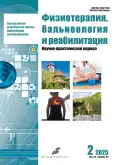多发性硬化患儿步态分析
- 作者: Borovik M.A.1,2, Vedernikov I.O.1, Laysheva O.A.1,2, Volkova E.Y.1, Kovalchuk T.S.1
-
隶属关系:
- Russian Children's Clinical Hospital
- The Russian National Research Medical University named after N.I. Pirogov
- 期: 卷 24, 编号 2 (2025)
- 页面: 84-96
- 栏目: Original studies
- URL: https://journal-vniispk.ru/1681-3456/article/view/316575
- DOI: https://doi.org/10.17816/rjpbr643515
- EDN: https://elibrary.ru/IDYRMY
- ID: 316575
如何引用文章
详细
论证。据不同文献报道,在被诊断为多发性硬化的患者中,儿童占比约3%–10%。在所有患者中,约75%在疾病早期即出现步态异常。然而,在俄罗斯联邦卫生部于2022年批准的临床指南中,尚无针对儿童步态分析的仪器评估方法的数据。
研究目的。 利用步态分析仪器结合表面肌电图,研究复发缓解型多发性硬化患儿的运动状态特征。
材料与方法。本研究为单中心、前瞻性观察性全样本研究。研究对象为Russian Children’s Clinical Hospital精神神经科确诊为多发性硬化的9–17岁患者(n=38)。所有患者均接受下肢肌群的步态分析和表面肌电图评估,同时进行了6分钟步行测试以及 增强磁共振成像以评估 脑部和脊髓病变情况。
结果。研究对象的残疾程度较低(EDSS评分≤2.5),均可独立行走。6分钟步行测试 结果显示,大多数患者的步行距离符合该年龄段正常范围,平均步行距离为520.92米。在表面肌电图分析中,44.74%的患者表现出腓肠肌在单腿支撑相期间的肌电活动异常,表现为肌肉过早激活以及步态周期支撑相的持续激活,并出现第二个峰值。
结论。研究发现,患儿对运动负荷的耐受性降低,并在表面肌电图评估中显示腓肠肌存在异常激活模式,即步态周期的非负重期持续激活以及支撑期的过早激活。这些变化可作为医学康复的潜在指征,并有助于评估治疗效果。由于样本量的限制,该现象仍需进一步研究。
作者简介
Margarita A. Borovik
Russian Children's Clinical Hospital; The Russian National Research Medical University named after N.I. Pirogov
编辑信件的主要联系方式.
Email: a1180@rambler.ru
ORCID iD: 0009-0004-9663-4805
SPIN 代码: 6307-8201
俄罗斯联邦, Moscow; Moscow
Igor O. Vedernikov
Russian Children's Clinical Hospital
Email: pulmar@bk.ru
ORCID iD: 0009-0006-1327-2525
SPIN 代码: 5047-2594
俄罗斯联邦, Moscow
Olga A. Laysheva
Russian Children's Clinical Hospital; The Russian National Research Medical University named after N.I. Pirogov
Email: olgalaisheva@mail.ru
ORCID iD: 0000-0002-8084-1277
SPIN 代码: 8188-2819
MD, Dr. Sci. (Medicine), Professor
俄罗斯联邦, Moscow; MoscowElvira Y. Volkova
Russian Children's Clinical Hospital
Email: ellivolk@yandex.ru
ORCID iD: 0000-0001-5646-3651
俄罗斯联邦, Moscow
Timofey S. Kovalchuk
Russian Children's Clinical Hospital
Email: doctor@tim-kovalchuk.ru
ORCID iD: 0000-0002-9870-4596
俄罗斯联邦, Moscow
参考
- Lubetzki C, Stankoff B. Demyelination in multiple sclerosis. Handb Clin Neurol. 2014;122:89–99. doi: 10.1016/B978-0-444-52001-2.00004-2
- Gusev EI, Konovalova AN, Geht AB. Neurology. National Leadership. Moscow: GEOTAR-Media; 2018. 688 p. (In Russ.)
- Halliday AM, McDonald WI. Pathophysiology of demyelinating disease. British medical bulletin. 1977;33(1):21–27.
- Ritchie JM. Pathophysiology of conduction in demyelinated nerve fibers. Myelin. Boston: Springer US; 1984.
- Domres NV. The features of the functional state of muscle fibers in patients with multiple sclerosis with spasticity according to the results of electroneuromyography. The Bulletin of Contemporary Clinical Medicine. 2020;13(5):46–56. doi: 10.20969/VSKM.2020.13
- Dorokhov AD, Shkilnyuk GG, Tsvetkova ТL, Stoliarov ID. Features of walking disorders in multiple sclerosis. Practical Medicine. 2019;17(7):28–32. doi: 10.32000/2072-1757-2019-7-28-32
- Eken MM, Richards R, Beckerman H, et al. Quantifying muscle fatigue during walking in people with multiple sclerosis. Clinical Biomechanics. 2020;72:94–101. doi: 10.1016/j.clinbiomech.2019.11.020
- Molina-Rueda F, Fernández-Vázquez D, Navarro-López V, et al. Muscle coactivation index during walking in people with multiple sclerosis with mild disability, a cross-sectional study. Diagnostics. 2023;13(13):2169. doi: 10.3390/diagnostics13132169
- Molina-Rueda F, Fernández-Vázquez D, Navarro-López V, et al. The timing of kinematic and kinetic parameters during gait cycle as a marker of early gait deterioration in multiple sclerosis subjects with mild disability. Journal of Clinical Medicine. 2022;11(7):1892. doi: 10.3390/jcm11071892
- Berg-Hansen P, Moen SM, Austeng A, et al. Sensor-based gait analyses of the six-minute walk test identify qualitative improvement in gait parameters of people with multiple sclerosis after rehabilitation. J Neurol. 2022;269:3723–3734. doi: 10.1007/s00415-022-10998-z
- Coca-Tapia M, Cuesta-Gómez A, Molina-Rueda F, Carratalá-Tejada M. Gait pattern in people with multiple sclerosis: a systematic review. Diagnostics. 2021;11(4):584. doi: 10.3390/diagnostics11040584
- Kotov SV, Petrushanskaya KA, Lizhdvoj VJ, et al. Сlinico-physiological foundation of application of exoskeleton “exoatlet” during walking of patients with disseminated sclerosis. Russian Journal of Biomechanics. 2020;24(2):148–166. doi: 10.15593/rzhbiomeh/2020.2.03
- Dorokhov AD, Ivashkova EV, Ilves AG, et al. Assessment of biomechanical parameters of feet in patients with multiple sclerosis during walking. Russian neurological journal. 2023;28(4):35–42. doi: 10.30629/2658-7947-2023-28-4-35-42
- Cofré Lizama LE, Strik M, Van der Walt A, et al. Gait stability reflects motor tracts damage at early stages of multiple sclerosis. Multiple sclerosis journal. 2022;28(11):1773–1782. doi: 10.1177/13524585221094464
- Kalron A, Frid L, Menascu S. Gait characteristics in adolescents with multiple sclerosis. Pediatric Neurology. 2017;68:73–76. doi: 10.1016/j.pediatrneurol.2016.11.004
- Ministry of Health of the Russian Federation. Clinical recommendations, multiple sclerosis in children. 2022. Available: http://disuria.ru/_ld/12/1226_kr22G35p0MZ.pdf (In Russ.)
- Winter DA, Yack HJ. EMG profiles during normal human walking: stride-to-stride and inter-subject variability. Electroencephalogr Clin Neurophysiol. 1987;67(5):402–411. doi: 10.1016/0013-4694(87)90003-4
- Bushueva EV, Gerasimova LI, Sharapova OV, et al. 6-minute walking test indicators in healthy children and adolescents. Practical medicine. 2023;21(1):80–86. doi: 10.32000/2072-1757-2023-1-80-86
- Rudolph KS, Axe MJ, Snyder-Mackler L. Dynamic stability after ACL injury: who can hop? Knee Surg Sports Traumatol Arthrosc. 2000;8(5):262–9. doi: 10.1007/s001670000130
- Falconer K, Winter DA. Quantitative assessment of co-contraction at the ankle joint in walking. Electromyogr Clin Neurophysiol. 1985;25(2–3):135–49.
- Li G, Shourijeh MS, Ao D, et al. How well do commonly used co-contraction indices approximate lower limb joint stiffness trends during gait for individuals post-stroke? Front Bioeng Biotechnol. 2021;8:588908. doi: 10.3389/fbioe.2020.588908
- Kiernan MC, Kaji R. Physiology and pathophysiology of myelinated nerve fibers. Handbook of clinical neurology. 2013;115:43–53.
- Cofré Lizama LE, Strik M, Van der Walt A, et al. Gait stability reflects motor tracts damage at early stages of multiple sclerosis. Mult Scler. 2022;28(11):1773–1782. doi: 10.1177/13524585221094464
补充文件














